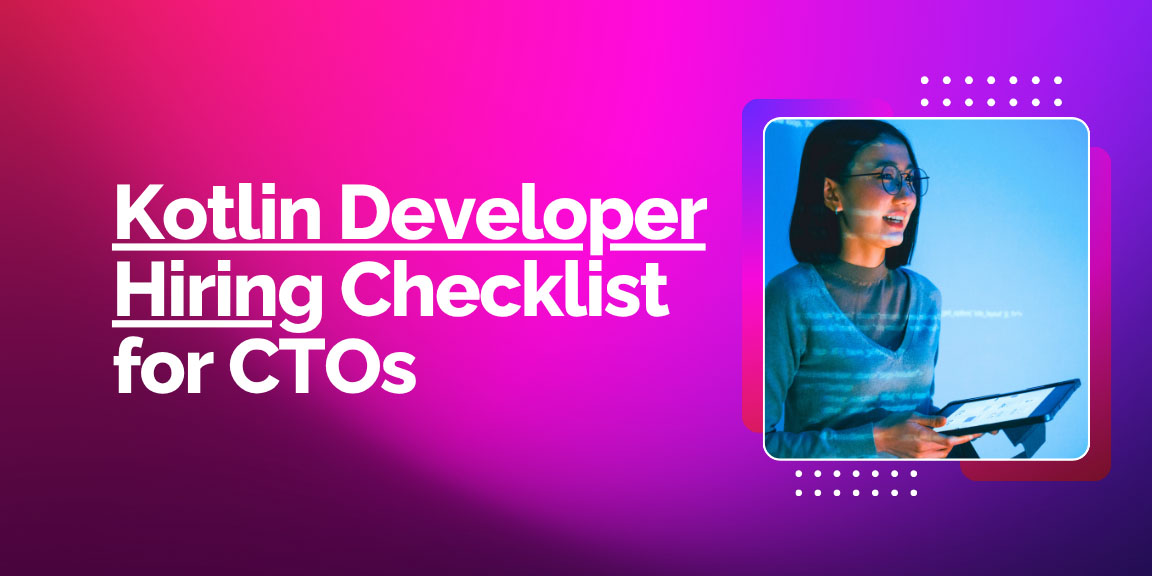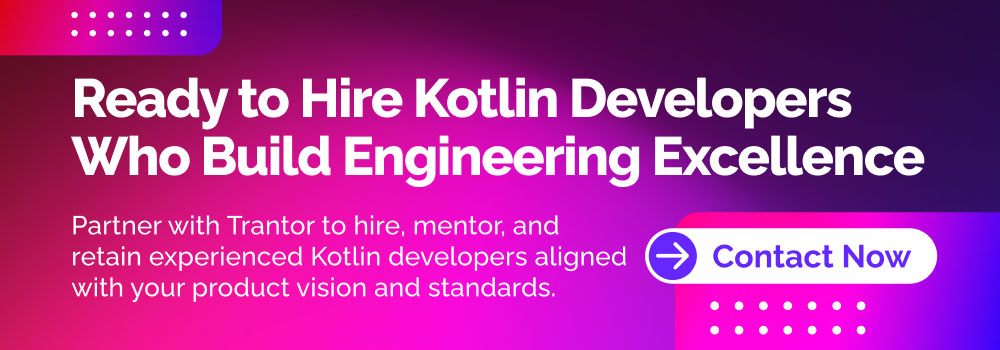Enterprise Application Development, zBlog
Hire Kotlin Developers: Essential Checklist for CTOs & Founders
trantorindia | Updated: October 17, 2025

In a world where mobile-first, cross-platform, and scalable backend systems dominate software strategy, Kotlin has emerged not just as a language for Android, but as a full-stack, multiplatform option. More companies are now seeking to hire Kotlin developers who can deliver modern, maintainable, and high-performance code across mobile and backend layers.
But hiring Kotlin talent is not trivial. CTOs and founders need to navigate aspects like platform specialization (Android vs. server vs. multiplatform), team structure, remote vs. on-site trade-offs, code standards, recruiting pipelines, and long-term retention.
This guide gives you the complete checklist to hire Kotlin developers effectively: from demand, skills, hiring models, interviewing, onboarding, metrics, pitfalls, to scaling a resilient Kotlin team.
Why Kotlin? Market Trends & Demand in 2025–2026
Before you commit resources, you need to understand why Kotlin is a compelling bet.
- Kotlin is recognized as one of the top 10 in-demand programming languages in 2025 according to rankings of languages in demand
- Kotlin usage is rising beyond Android into backend, server, and web frameworks like Ktor and Kotlin + Spring Boot
- Some job boards report surges in Kotlin framework job postings (e.g. +30%) in recent years.
- In the UK, the number of permanent jobs requiring Kotlin has been tracked and median salaries remain strong.
- Kotlin’s interoperability with Java remains a strong advantage — you can integrate Kotlin modules smoothly in existing JVM architecture.
So for CTOs and founders, Kotlin offers:
- Modern syntax with safety (null safety, coroutines, expressive DSLs)
- Interoperability with existing Java code
- Multiplatform potential (share logic between Android, iOS, JS)
- Growing ecosystem especially in Android and backend
- Strong developer adoption and community support
Hence, hiring Kotlin developers is an investment in future-proofing your architecture.
Core Types / Specializations of Kotlin Developers
When you plan to hire Kotlin developers, it’s vital to differentiate among specializations. Not all Kotlin developers are the same.
Your hiring checklist should account for which specialization you need — trying to hire a jack-of-all with deep expertise in all domains is difficult and risky.
What to Look for: Skills & Experience When Hiring Kotlin Developers

Here’s a checklist of must-have vs. nice-to-have skills:
Must-Have Technical Skills
- Proficiency in Kotlin language features: data classes, extension functions, generics, sealed classes, null safety
- Understanding of coroutines and concurrency
- Experience with Android architecture components (for mobile side) or Ktor / Spring Boot / Micronaut (for backend)
- Familiarity with REST, JSON, GraphQL APIs
- Experience with unit testing, integration testing, mocking
- Solid Git & version control practices
- Knowledge of memory management, performance profiling, leak detection
- Strong debugging skillset
- Understanding of clean architecture, dependency injection
Highly Desirable / Bonus Skills
- Experience in Kotlin Multiplatform or shared codebases
- Familiarity with Compose UI (Android)
- Knowledge of native interop / JNI
- Familiarity with DevOps / CI-CD pipelines
- Exposure to cloud services / serverless
- Experience migrating from Java to Kotlin
- Contribution to open-source Kotlin projects or libraries
Soft Skills & Engineering Traits
- Problem-solving and algorithmic thinking
- Clear communication and code documentation
- Self-driven and disciplined, especially in remote setups
- Team collaboration and code review mindset
- Ability to give and receive constructive feedback
- Adaptability and continuous learning
Hiring Models: Onsite, Remote, Hybrid, Managed Teams
When you choose to hire Kotlin developers, you should decide the engagement model. Each has trade-offs:
For many CTOs, a hybrid / remote dedicated model often offers the best balance of cost, control, and talent access.
Step-by-Step Checklist for Hiring Kotlin Developers

Here’s a method you can follow to hire competent Kotlin developers:
Step 1: Define Role, Scope & Level
- Clarify specialization (mobile, backend, multiplatform)
- Determine seniority (junior, mid, senior, lead)
- Define deliverables, milestones, metrics
Step 2: Create Attractive Job Description
- Emphasize Kotlin-based stack
- List required and desirable skills
- Highlight remote work flexibility and tech challenges
- State evaluation process (coding test, interview, etc.)
Step 3: Source Candidates
- Use platforms like LinkedIn, Kotlin/Android developer communities
- Specialized job boards (Stack Overflow Jobs, AngelList)
- Open source Kotlin community contributors
- Referrals from your engineering network
Step 4: Preliminary Screening
- Review resumes for relevant Kotlin + domain experience
- Filter out candidates who only list Kotlin casually
Step 5: Technical Evaluation
- Assign coding test (small module or bug fix)
- Assess code style, readability, correctness, performance
- Conduct pair programming or live problem solving
- Ask about coroutine usage, concurrency, architecture decisions
Step 6: Behavioral & Culture Fit Interview
- Communication skills and clarity
- Approach to problem solving
- Remote work habits and discipline
- Team collaboration and code review attitude
Step 7: Reference Checks & Soft Validation
- Talk to former managers about delivery, teamwork, responsiveness
- Validate actual Kotlin work claimed
Step 8: Offer & Onboarding
- Competitive compensation offer
- Define role charter, mentors, and codebase orientation
- Provide documentation, coding standards, dev environment setup
Step 9: Probation / Trial Period
- First 2–3 months as probationary time
- Deliver small features or bug fixes
- Monitor code quality, velocity, responsiveness
Step 10: Continuous Feedback and Growth
- Regular 1:1s, performance reviews
- Technical mentorship and training budgets
- Career path for Kotlin devs into architect or team lead roles
Compensation, Market Benchmarks & Trends

To attract top talent, your offers must be competitive:
- In the U.S., experienced Kotlin developers can command $120,000 – $160,000+ annually (or more in high-cost markets).
- In many European markets, Kotlin roles are priced similarly to senior Java or Scala engineers.
- In the UK, median salaries for roles citing Kotlin are about £62,500.
- In emerging markets, Kotlin developers may earn a fraction but you can attract quality remote talent.
- Compensation should include base salary, bonuses, equity, training budget, remote perks, and flexible work options.
Metrics & KPIs to Track After Hiring

To ensure your new Kotlin hires are impactful, monitor:
- Cycle time per feature
- Code review turnaround
- Number of bugs / severity in production
- Deployment frequency and rollback rate
- Performance improvements (API latency, memory usage)
- Retention and developer satisfaction
- Contribution to codebase health (refactoring, tests)
Common Pitfalls & How to Avoid Them
Real-World Use Cases & Case Studies
Case 1: Mobile Startup Migrating Java to Kotlin
A startup had its Android app in Java but wanted better maintainability and modern architecture. They hired Kotlin engineers to gradually migrate modules. Over 12 months, crash rates dropped 40%, and feature velocity increased 25%.
Case 2: Backend Microservices in Kotlin
A SaaS company transitioned parts of its monolith to Kotlin + Ktor microservices. They hired Kotlin backend devs to design APIs, manage concurrency, and scale. The result: better throughput, lower GC overhead, and more modular code.
Case 3: Shared Business Logic via Kotlin Multiplatform
A company building mobile apps for Android and iOS used Kotlin Multiplatform for shared logic. They hired developers who could deliver both mobile and shared modules. This reduced duplication and accelerated release cycles.
Frequently Asked Questions (FAQs)
Q: Can Kotlin developers work on both mobile & backend? Yes, with proper experience in shared logic or multiplatform, many Kotlin developers can traverse mobile and backend domains.
Q: How steep is the learning curve from Java to Kotlin? Relatively shallow — Kotlin is interoperable with Java. Many teams adopt Kotlin gradually and rewrite modules over time.
Q: Does Kotlin replace Java entirely? Not necessarily. Kotlin complements Java and coexists in ecosystems. Many codebases use both.
Q: How do I retain top Kotlin talent? Offer growth paths, mentorship, challenging projects, good compensation, and a healthy engineering culture.
Q: What’s the risk of hiring remote Kotlin developers? Communication, context switching, and culture mismatch are risks. Mitigate with structured onboarding, codified processes, and team syncs.
Conclusion: Partner with Trantor to Hire Kotlin Developers Right
Hiring Kotlin developers properly is not just about filling seats — it’s about building engineering excellence, sustainable codebases, and an engaged team aligned with your product vision.
At Trantor, we understand the nuances of scaling technical teams. Whether you’re building a mobile-native Kotlin app, a Kotlin microservices backend, or exploring Kotlin Multiplatform logic, our seasoned engineers and recruitment leadership help you hire, mentor, and retain the best talent.
By choosing to hire Kotlin developers through a trusted partner, you gain:
- Vetted, experienced Kotlin experts
- Rapid team ramp-up without administrative overhead
- Guided onboarding, standards, and code reviews
- Long-term support and mentorship
👉 If you’re ready to scale your engineering team with high-quality Kotlin talent and focus on product rather than hiring friction, explore Trantor’s partnership and let us help you build the team you need.
Visit Trantor




